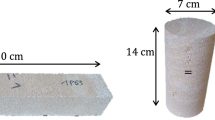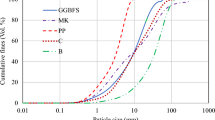Abstract
Water, which is an important factor considering the decay of building stones, dissolves salts and causes them to move into the pores in stones. Salts are the most important deterioration agents for stones. Three low-porous limestones (beige-cream marble) were examined in this research. The selected limestone samples are characterized by mineralogical-petrographic (optical microscope, SEM), chemical (XRF), and mechanical-physical properties. The durability of the tested limestones was investigated using a salt crystallization test according to TS EN 12,370. These tests were conducted by applying immersion-drying cycles with water containing sodium sulfate or sodium chloride. The weight loss of the samples was determined after 15 cycles. Changes in the structure of the limestones (beige-cream marble) after these salt crystallization tests were determined using SEM, uniaxial compressive strengths, and ultrasonic wave measurements. According to test results of the salt crystallization values, all tested limestones had a dry weight loss of less than 1.0%. The ultrasonic sound velocity and uniaxial compressive strengths were measured before and after the tests. The analysis of the strength test results on samples subjected to salt crystallization showed a decreased resistance for the limestones. This situation is confirmed by decreased P-wave velocity values. The changes reached from 2.12 to 14.67% for sodium sulfate solution. These ratios were in the range of 2.64 to 10.66% at the sodium chloride solution. Results suggested that the beige-cream marbles are fine-grained limestone, characterized by low porosity and, consequently, very notable salt crystallization resistance.


modified from MTA 2021)













Similar content being viewed by others
References
Alonso FJ, Vázquez P, Esbert RM, Ordaz J (2008) Ornamental granite durability: evaluation of damage caused by salt crystallization test. Mater Constr 58:191–202
Alves C, Figueiredo C, Maurίcio A, Braga MAS, Aires-Barros L (2011) Limestones under salt decay tests: assessment of pore network-dependent durability predictors. Environ Earth Sci 63:1511–1527
ASTM D5240 (2013) ASTM Subcommittee D18.17 standard test method for evaluation of the durability of rock for erosion control using sodium sulfate or magnesium sulfate
Barbera G, Barone G, Mazzoleni P, Scandurra A (2012) Laboratory measurement of ultrasound velocity during accelerated aging tests: implication for the determination of limestone durability. Constr Build Mater 36:977–983
Bayram U (1997) Tefenni-Karamanlı (Burdur) çevresinin jeolojisi. Dissertation, University of Süleyman Demirel
Benavente D, Garcìa del Cura MA, Fort R, Ordonez S (1999) Thermodynamic modelling of changes induced by salt pressure crystallization in porous media of stone. J Cryst Growth 204:168–178
Benavente D, Garcia Del Cura MA, Bernabe UA, Ordonez S (2001) Quantification of salt weathering in porous stones using an experimental continuous partial immersion method. Eng Geol 59:313–325
Benavente D, Garcia Del Cura MA, Ordonez FR (2004) Durability estimation of porous building stones from pore structure and strength. Eng Geol 74:113–127
Briffa SM, Vella DA (2019) The behaviour of as-applied and artificially weathered silica–epoxy consolidants on a typical Mediterranean porous limestone: a comparison with TEOS. Herit Sci 7:30
Calvo JP, Regueiro M (2010) Carbonate rocks in the Mediterranean region—from classical to innovative uses of building stone. Geological Society, London, Special Publications 331(1):27–35
Carlson DH, Plummer CC, McGeary D (2008) Physical geology forth revealed, 7th edition. McGraw-Hill International Edition, pp. 360–376, pp. 241–249
CEN EN 12370 (1999) Natural stone test methods. Determination of resistance to salt crystallisation
Ceryan S, Tudes S, Ceryan N (2008) Influence of weathering on the engineering properties of Harsit granitic rocks (NE Turkey). Bull Eng Geol Environ 67:97–104
Clifton JR (1980) Stone consolidating materials—a status report. US Dep Commer Nat Bur Stand, NBS Tech Note 1118:46
Cox KG, Price NB, Harte B (1974) The practical study of crystals, minerals and rocks, McGraw Hill International Editions 104–124, 201–207
Coussy O (2006) Deformation and stress from in-pore drying-induced crystallization of salt. J Mech Phys Solids 54:1517–1547
Çelik MY, Aygün A (2019) The effect of salt crystallization in porous building stones by sodium sulfates and sodium chlorides on degradation. Bull Eng Geol Environ 78(5):509–3529
Çelik MY, Sert M (2020) The role of different salt solutions and their concentration ratios in salt crystallization test on the durability of Döğer tuff (Afyonkarahisar-Turkey) used as building stones of cultural heritages. Bull Eng Geol Environ 79:5553–5568
Derluyn H, Moonen P, Carmeliet J (2014) Deformation and damage due to drying-induced salt crystallization in porous limestone. J Mech Phys Solids 63:242–255
Di Benedetto C, Cappelletti P, Favaro M et al (2015) Porosity as key factor in the durability of two historical building stones: Neapolitan Yellow Tuff and Vicenza Stone. Eng Geol 193:310–319
Doehne E (1994) In situ dynamics of sodium sulfate hydration and dehydration in stone pores: observations at high magnification using the environmental scanning electron microscope. Fassina, O. A. Z., editor, The Conservation of Monuments in the Mediterranean Basin. (Venice, Italy) 143–150
Dunham RJ (1962) Classification of carbonate rocks according to depositional texture. in: Ham WE (ed.), Classification of carbonate rocks. Am Assoc Petr Geol Mem 1:108–121
Elitez İ (2010) Çameli ve Gölhisar havzalarinin Miyosen-Kuvaterner jeodinamiği, Burdur-Fethiye fay zonu, GB Türkiye. Dissertation, University of Süleyman Demirel, Turkey
Espinosa Marzal RM, Scherer GW (2008) Crystallization of sodium sulfate salts in limestone. Environ Geol 56:605–621
Espinosa-Marzal RM, Hamilton A, McNall M, Whitaker K, Scherer GW (2011) The chemomechanics of crystallization during rewetting of limestone impregnated by sodium sulfate. J Mater Res 26:1472–1481
Fioretti G, Mazzoleni P, Acquafredda P, Andriani GF (2018) On the technical properties of the Carovigno stone from Apulia (Italy): physical characterization and decay effects by means of experimental ageing tests. Environ Earth Sci 77:17
Flatt RJ (2002) Salt damage in porous materials: how high supersaturations are generated. J Cryst Growth 242:435–454
Folk RL (1962) Spectral subdivision of limestone types, in: Ham WE (ed.), Classification of carbonate Rocks-A Symposium. Am Assoc Petr Geol Mem 1:62–84
Genç Ş (1986) Geology of the region between Uludağ and the İznik Lake. MTA Report no: 7853 (unpublished), Ankara
Germinario L, Török Á (2020) Surface weathering of tuffs: compositional and microstructural changes in the building stones of the medieval Castles of Hungary. Minerals 10:376
Goudie AS (1993) Salt weathering simulation using a single immersion technique. Earth Surf Processes Landforms 18:368–376
Goudie AS, Viles HA (1995) The nature and pattern of debris liberation by salt weathering: a laboratory study. Earth Surf Processes Landforms 20:437–449
Goudie AS, Viles HA (1997) Salt weathering hazard. Wiley, London
Goudie AS (1999) Experimental salt weathering of limestone in relation to rock properties. Earth Surf Processes Landforms 24:715–724
Kramar S, Mladenovič A, Kozamernik M, Mirtič B (2010) Durability evaluation of some Slovenian building limestones. RMZ-Materials and Geoenvironment 57(3):331–346
Lazzarini L, Laurenzi TM (1986) Il restauro della pietra. CEDAM, Padova
Lubelli B, Nijland TG (2014) Damage mechanism in Tournai limestone—the case of the tomb of Admiral Tromp in the Old Church of Delft (The Netherlands) J Cult Heritage 15:313–317
Matovic V, Eric S, Sreckovic-Batocanin D, Colomban P, Kremenovic A (2014) The influence of building materials on salt formation in rural environments. Environ Earth Sci 72(6):1939–1951
Molina E, Cultrone G, Sebastian E, Alonso FJ (2013) Evaluation of stone durability using a combination of ultrasound, mechanical and accelerated aging tests. J Geophys Eng 10:035003
Montero R (2020) 18 types of beige marble alternatives to Crema Marfil. Design & Construction by Albora International. https://alborainternational.com/en/types-of-beige-marble-alternatives-to-crema-marfil/
Morillas H, Filho FFM, Derluyn H, Maguregui M, Grégoire D, Madariaga JM (2020) Decay processes in buildings close to the sea induced by marine aerosol: salt depositions inside construction materials, Science of the Total Environment 721:137687
MTA (2021) Earth sciences map viewer and drawing editor. http://yerbilimleri.mta.gov.tr/anasayfa.aspxAccessed 22 Jan 2021
Okay AI, Tüysüz O (1999) Tethyan sutures of northern Turkey. In: Durand B, Jolivet L, Horváth F, Séranne M (Eds.), The Mediterranean Basins: Tertiary extension within the Alpine orogen. 156. Geological Society of London, Special Publication, pp 475–515
Ordonez S, Fort R, Garcia del Cura MA (1997) Pore size distribution and the durability of a porous limestone. Q J Eng Geol 30:221–230
Prikryl R, Lokajíček T, Svobodová JW (2003) Experimental weathering of marlstone from Přední Kopanina (Check Republic)—historical building stone of Prague. Build Environ 38:1163–1171
Price DG (1995) Weathering and weathering processes. Q J Eng Geol 28:243–252
RILEM TC 127-MS (1998) MS-A.2-uni-directional salt crystallisation test for masonry units. Mater Struct 31:10–11
Rodriguez-Navarro C, Doehne E (1999) Salt weathering: influence of evaporation rate, supersaturation and crystallization pattern. Earth Surf Process Landf 24(3):191–209
Rodríguez Navarro C, Doehne E, Sebastian E (2000) How does sodium sulfate crystallize? implications for the decay and testing of building materials. Cem Concr Res 30:1527–1534
Ruiz-Agudo E, Mees F, Jacobs P, Rodriguez Navarro C (2007) The role of saline solution properties on porous limestone salt weathering by magnesium and sodium sulfates. Environ Geol 52:269–281
Sarı B (2006) Upper Cretaceous planktonic foraminiferal biostratigraphy of the Bey Daǧlari autochthon in the Korkuteli area, Western Taurides. Turkey Journal of Foraminiferal Research 36(3):241–261
Scrivano S, Gaggero L (2020) An experimental investigation into the salt-weathering susceptibility of building limestones. Rock Mech Rock Eng 53:5329–5343
Sperling CHB, Cooke RU (1985) Laboratory simulation of rock weathering by salt crystallisation and hydration processes in hot, arid environments. Earth Surf Process Landf 10:541–555
Spry A (1989) Stone testing ± general, stone in modern buildings: the state of the art, Seminar notes, Sydney 45–57
Steiger M, Asmussen S (2008) Crystallization of sodium sulfate phases in porous materials: the phase diagram Na2SO4–H2O and the generation of stress. Geochim Cosmochim Acta 72:4291–4306
Sun Q, Dong Z, Jia H (2019) Decay of sandstone subjected to a combined action of repeated freezing–thawing and salt crystallisation. Bull Eng Geol Environ 78:5951–5964
Şenel M, Selçuk H, Bilgin ZR, Şen AM, Karaman T, Erkan M, Kaymakçı H, Örçen S, Bilgi C (1987) Likya napları ön cephe özellikleri. Türkiye Jeoloji Kurultayı, Bildiri özleri, 8 Ankara
Theoulakis P, Moropoulou A (1999) Salt crystal growth as weathering mechanism of porous stone on historic masonry. J Porous Mater 6:345–358
TS EN 1926 (2007) Natural stone test methods-determination of uniaxial compressive strength. Turkish Standards Institute, Ankara, Turkey, 19 pp
TS EN 1936 (2010) Natural stone test methods-determination of real density and apparent density and of total and open porosity. Turkish Standards Institute, Ankara, Turkey, 10 pp
TS EN 12370 (2020) Natural stone test methods-determination of resistance to salt crystallization. Turkish Standards Institute, Ankara, Turkey, 8 pp
TS EN 13755 (2009) Natural stone test methods-determination of water absorption at atmospheric pressure. Turkish Standards Institute, Ankara, Turkey, 10 pp
TS EN 14579 (2006) Natural stone test methods: determination of sound speed propagation. Turkish Standards Institute, Ankara, Turkey, 14 pp
Tsui N, Flatt RJ, Scherer GW (2003) Crystallization damage by sodium sulfate. J Cult Herit 4:109–115
Urosevic M, Sebastian E, Cardell C (2013) An experimental study on the influence of surface finishing on the weathering of a building low-porous limestone in coastal environments. Eng Geol 154:131–141
Vasconcelos G, Lourenço PB, Alves CAS, Pamplona J (2008) Ultrasonic evaluation of the physical and mechanical properties of granites. Ultrasonics 48:453–466
Yalçınkaya S, Avşar ÖP (1980) Geology of the Mustafakemalpaşa (Bursa) region. MTA Report no: 6717 (unpublished), Ankara
Yu S, Oguchi CT (2010) Role of pore size distribution in salt uptake, damage, and predicting salt susceptibility of eight types of Japanese building stones. Eng Geol 115:226–236
Zhang H (2011) Building materials in civil engineering. Woodhead Publishing Limited Science Press, Beijing p 432
Zedef V, Kocak K, Ozsen DA, H, Kekec B (2007) Effect of salt crystallization on stones of historical buildings and monuments, Konya, Central Turkey. Build Environ 42:1453–1457
Author information
Authors and Affiliations
Corresponding author
Rights and permissions
About this article
Cite this article
Çelik, M.Y., Ozkan, O. Geotechnical characterization of low-porous limestones (beige–cream marble, Turkey) and evaluation of durability by salt crystallization experiments. Bull Eng Geol Environ 81, 56 (2022). https://doi.org/10.1007/s10064-021-02560-4
Received:
Accepted:
Published:
DOI: https://doi.org/10.1007/s10064-021-02560-4




